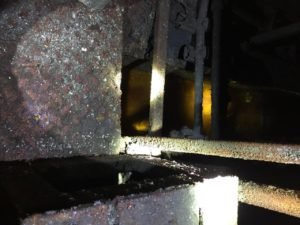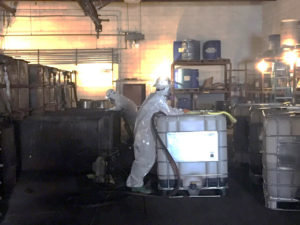By JANE MCCLURE
All photos courtesy of the US EPA
Weeks of hazardous materials cleanup at an abandoned Hamline-Midway metal plating plant reached a turning point as November began. The federal Environmental Protection Agency (EPA) is completing its work at Plating Inc. and is handing off ongoing site monitoring and next steps to city, county, and state officials. While neighbors are glad to hear of progress, they have a message for elected officials.
 Photo right: Overview of the Plating Inc. exterior at 888 N. Prior Ave.; facing south.
Photo right: Overview of the Plating Inc. exterior at 888 N. Prior Ave.; facing south.
“I hope our state and city and county officials don’t forget us and leave us behind,” said Plating Inc. neighbor Dee Schleifer. “You guys don’t live here. Please don’t forget us.”
Keeping the community informed is a priority moving ahead, said Ward Four City Council Member Russ Stark. His office will take over community outreach centered on the cleanup. He suggested that officials meet again with neighbors in January.
More than 30 people attended an Oct. 26 community meeting at Newell Park to hear from federal, state and local officials about Plating Inc., 888 N. Prior Ave. The property housed plating operations since 1938, but the most recent owners apparently walked away in 2016 for financial reasons. Not only were chemicals left in open vats and trenches, the building was the subject of break-ins and copper theft.
 Photo left: At the Plating Inc. site, crew members spray water on insulation bricks that contain friable asbestos to reduce the dispersion of the particles during removal.
Photo left: At the Plating Inc. site, crew members spray water on insulation bricks that contain friable asbestos to reduce the dispersion of the particles during removal.
Neighbors are concerned about past waste disposal practices, and whether yards, gardens and a pond along Pierce Butler Route are polluted. They asked for help to pay for soil testing in their yards and gardens. Local and state officials will check into those issues.
The EPA went in in late August with a “time critical” removal and cleanup plan. EPA On-Site Coordinator David Morrison described the complex cleanup over the past several weeks. Crews had to deal with more than 80 open vats of chemicals. The building had a blue haze in the air from leaks and chemical interaction with moisture. The building’s plumbing system had frozen. The lack of maintenance meant asbestos pieces had fallen inside. That mess had to be cleaned up before chemical cleanup and removal could begin.
Then the most caustic and dangerous chemicals had to be contained. Strong acids were found in vats. Chemicals had to be tested to see what they were, with samples from every vat and drum.
 Photo right: Pooled, liquid waste was removed from under the waste treatment lines.
Photo right: Pooled, liquid waste was removed from under the waste treatment lines.
The EPA secured more than 20,000 gallons of hazardous acids and caustic materials from open vats. About 80 drums of caustic and acidic solids and other industrial sludge were contained from vats and containers. About 9,700 gallons of waste liquids were pumped from open vats into tanker trucks. Lab packs containing 849 pounds of hazardous waste stored in small-volume containers were also shipped off for disposal, along with another 1,400 pounds of non-hazardous waste used metal plating. Overhead lines and processing equipment had to be dismantled and drained.
Efforts were made to recycle some of the chemicals. But some were congealed and couldn’t be pumped out. Those materials were removed manually. The building has had 24-hour security. Air monitors were placed in and around the property.
By early November the EPA and its contractors were shifting from cleanup to disposal. That means taking bids on items and getting them taken away. Once disposal is set, the remaining hazardous materials will be gone. Metal vats can be cleaned and scrapped out. An underground tank containing about 1,100 gallons of diesel fuel will be pumped out.
 Photo left: Caustic solution release in floor trench at Plating Inc.
Photo left: Caustic solution release in floor trench at Plating Inc.
The EPA trailer will be gone. The goal is for the work to wrap up by early December. Congresswoman Betty McCollum said that it’s fortunate that the mess was found before the U.S. was hit by hurricanes in late summer and fall. Natural disasters would have meant a slower EPA response.
“There’s still a big job ahead,” Morrison said. But part of that job will be shouldered by the state, county, and city.
“Once the EPA is done the city, county and state all have roles to play,” Stark said.
Minnesota Pollution Control Agency (MPCA) and Department of Health, and St. Paul-Ramsey County Public Health and St. Paul Department of Safety and Inspections (DSI) workers then step in.
The MPCA’s role is remediation, with the property likely going into a state cleanup program. State and county officials’ future work will also include monitoring a 500-foot industrial well in the building basement and determining what to do with a smaller well that is clogged and cannot be checked. Water samples were taken from the deeper well.
 Photo right: Crew members pumping fluid from a vat into a sealed tote for proper storage and transportation.
Photo right: Crew members pumping fluid from a vat into a sealed tote for proper storage and transportation.
Stark said the city also has jurisdiction over the property as a vacant structure. DSI Deputy Director Travis Bistodeau said the building is a Category Two—meaning it has property code problems that need correction before it could be sold and reoccupied.
Another concern is the fate of the property itself. The current owners are in arrears on property taxes, and over time the site could go into tax forfeiture and eventually be sold to a new owner. Stark and County Commissioner Toni Carter are seeing if that process could be expedited. City officials have heard there is a party interested in buying the property.
Officials haven’t said yet what penalties the current property owners face as an investigation is still ongoing.
Comments
No comments on this item Please log in to comment by clicking here